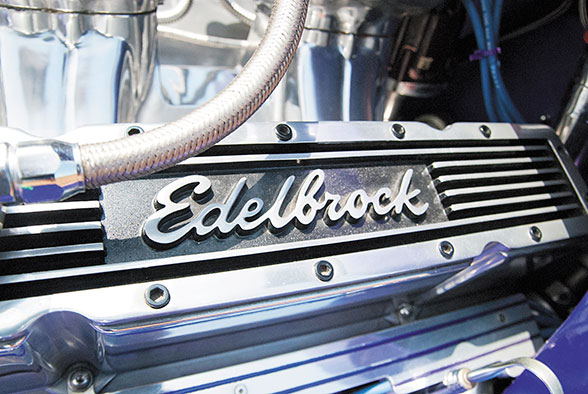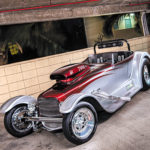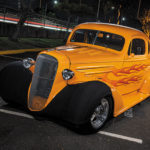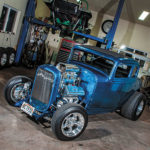SP Rides: This Ford Fits to a ‘T’
BY JERRETTE KAMAKA
1926 Model T Coupe Mods
YEAR: 1926
MAKE: Ford
MODEL: Model T 5-window coupe (aka Tall T)
ENGINE: 350 cc Chevy, dual tunnel ram, two Edelbrock 600 cfm carburetors, Erickson hydraulic 454 lift cam kit, Sanderson headers, Billet air filter
DRIVETRAIN: 350 3-speed automatic transmission, 350 shift kit, Floor Master dual exhaust, Holley electric fuel pump, Vega steering box
SUSPENSION: Chrome 6-inch drop tubular axle, XJ6 Jaguar rear end
WHEELS: Billet Wheels, 17×8 Front 215/45ZR17 Toyo tires, Talledega 17×9 Rear 255/60X17 tires
ELECTRONICS: MSE Ignition, EZ Wiring
INTERIOR: Original steering column modified, T steering wheel, custom pleat upholstery, Ford motor sport gauges, bench seat from a station wagon
STEREO: Pioneer CD stereo system
EXTERIOR: All steel body, PPG violet pearl, PPG polyurethane flo-clear, flames by Undertaker Kamaile, Total Performance brass radiator, chrome tunnel ram, Edelbrock chrome valve covers, dual chrome airfilter
When Glenn Barretto spotted this 1926 Model T 5-window coupe for sale nearly two decades ago, he was more interested in the condition of its frame and body than the state of its engine. So, despite the fact this classic automobile’s motor couldn’t turn over, he immediately forked over $4,000 for the car of his childhood dreams.
After all, he had big plans for this his second Model T.
“The first one was a 1927 Model T roadster that I had in the early ’80s,” Barretto explained. “For this one, I knew I wanted to build a street rod with a Chevy engine and a Jag rear-end. But first I had to take off the body, box the frame and then I made the cross-member for the rear end.”
After fabricating a cross-member and bolting up the rear end, Barretto noticed the body was sitting higher than preferred. The only solution was to buy a Jaguar cross-member, which solved the problem and also exposed the working parts of the independent rear suspension for everyone to admire.
“I sent all the parts of the rear end to the Mainland to get chromed,” he explained. “The Independent is real nice. It has the housing next to the disc brakes and then the axles all moving around, not like the Ford 9-inch. Then I picked up the tube-dropped front axle and installed that, but when I took the car on the road, oh boy! The car was all over the road, so I needed to align the front end.”
The all-chrome front end came with adjustable toe and camber, but it was the addition of six degrees of positive caster “that made all the difference in the car’s handling,” Barretto added. “With the new front end came the difficulty of fitting the block and headers into the narrow engine space.
“I bought an El Camino because it had this engine and transmission in it. So, when I put the engine in I borrowed my friend’s block hugger headers to set everything in place, and later on I bought a set of block huggers. But the set I got didn’t fit it because it was hitting the firewall.”
Sanderson Headers no longer made the set of block huggers Barretto borrowed from his friend, so he modified and powder-coated his set so that it would fit better. To his chagrin, however, the air cleaner that sat atop the dual quads wasn’t well suited for the firewall, forcing Barretto to come up with this creative cowl design.
“I’ve had this car for a long time and I’ve listed it,” said Barretto. “I think it’s time to let it go. But, for the past few years, I’ve been building a 1933 Speedster, and it’s about two years away from being completed.”












